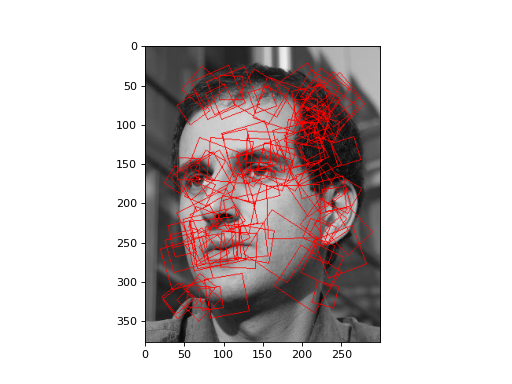Speeded-Up Robust Features¶
New in version 0.8: In version 0.8, some of the inner functions are now in mahotas.features.surf instead of mahotas.surf
Speeded-Up Robust Features (SURF) are a recent innovation in the local features family. There are two steps to this algorithm:
Detection of interest points.
Description of interest points.
The function mahotas.features.surf.surf combines the two steps:
import numpy as np
from mahotas.features import surf
f = ... # input image
spoints = surf.surf(f)
print("Nr points: {}".format(len(spoints)))
Given the results, we can perform a simple clustering using, for example, ` scikit-learn:
try:
from sklearn.cluster import KMeans
# spoints includes both the detection information (such as the position
# and the scale) as well as the descriptor (i.e., what the area around
# the point looks like). We only want to use the descriptor for
# clustering. The descriptor starts at position 5:
descrs = spoints[:,5:]
# We use 5 colours just because if it was much larger, then the colours
# would look too similar in the output.
k = 5
values = KMeans(n_clusters=k).fit(descrs).labels_
colors = np.array([(255-52*i,25+52*i,37**i % 101) for i in range(k)])
except:
values = np.zeros(100)
colors = [(255,0,0)]
So we are assigning different colours to each of the possible
The helper surf.show_surf draws coloured polygons around the
interest points:
f2 = surf.show_surf(f, spoints[:100], values, colors)
imshow(f2)
show()
Running the above on a photo of luispedro, the author of mahotas yields:
from __future__ import print_function
import numpy as np
import mahotas as mh
from mahotas.features import surf
from matplotlib import pyplot as plt
f = mh.demos.load('luispedro', as_grey=True)
f = f.astype(np.uint8)
spoints = surf.surf(f, 4, 6, 2)
print("Nr points:", len(spoints))
try:
from sklearn.cluster import KMeans
descrs = spoints[:,5:]
k = 5
values = KMeans(n_clusters=k).fit(descrs).labels_
colors = np.array([(255-52*i,25+52*i,37**i % 101) for i in range(k)])
except:
values = np.zeros(100, int)
colors = np.array([(255,0,0)])
f2 = surf.show_surf(f, spoints[:100], values, colors)
fig,ax = plt.subplots()
ax.imshow(f2)
fig.show()
(Source code, png, hires.png, pdf)

API Documentation¶
The mahotas.features.surf module contains separate functions for all the steps in
the SURF pipeline.
- mahotas.features.surf.dense(f, spacing, scale={np.sqrt(spacing)}, is_integral=False, include_interest_point=False)
desc_array = dense(f, spacing, scale={np.sqrt(spacing)}, is_integral=False, include_interest_point=False)
- Parameters:
- fimage
original image
- spacinginteger
Distance between points
- scalefloat, optional
Scale of interest points. By default, it is set to
np.sqrt(spacing)- is_integralboolean, optional
Whether f is an integral image
- include_interest_pointbool, optional
Whether to return interest point information. Default is False
- Returns:
- descriptorsndarray
Descriptors at dense points. Note that the interest point is not returned by default.
See also
surffunction Find interest points and then compute descriptors
descriptorsfunction Compute descriptors at user provided interest points
- mahotas.features.surf.integral(f, in_place=False, dtype=<class 'numpy.float64'>)
fi = integral(f, in_place=False, dtype=np.double):
Compute integral image
- Parameters:
- fndarray
input image. Only 2-D images are supported.
- in_placebool, optional
Whether to overwrite f (default: False).
- dtypedtype, optional
dtype to use (default: double)
- Returns:
- findarray of dtype of same shape as f
The integral image
- mahotas.features.surf.surf(f, nr_octaves=4, nr_scales=6, initial_step_size=1, threshold=0.1, max_points=1024, descriptor_only=False)
points = surf(f, nr_octaves=4, nr_scales=6, initial_step_size=1, threshold=0.1, max_points=1024, descriptor_only=False):
Run SURF detection and descriptor computations
Speeded-Up Robust Features (SURF) are fast local features computed at automatically determined keypoints.
- Parameters:
- fndarray
input image
- nr_octavesinteger, optional
Nr of octaves (default: 4)
- nr_scalesinteger, optional
Nr of scales (default: 6)
- initial_step_sizeinteger, optional
Initial step size in pixels (default: 1)
- thresholdfloat, optional
Threshold of the strength of the interest point (default: 0.1)
- max_pointsinteger, optional
Maximum number of points to return. By default, return at most 1024 points. Note that the number may be smaller even in the case where there are that many points. This is a side-effect of the way the threshold is implemented: only
max_pointsare considered, but some of those may be filtered out.- descriptor_onlyboolean, optional
If
descriptor_only, then returns only the 64-element descriptors (default isFalse).
- Returns:
- pointsndarray of double, shape = (N, 6 + 64)
N is nr of points. Each point is represented as (y,x,scale,score,laplacian,angle, D_0,…,D_63) where y,x,scale is the position, angle the orientation, score and laplacian the score and sign of the detector; and D_i is the descriptor
If
descriptor_only, then only the D_is are returned and the array has shape (N, 64)!
References
Herbert Bay, Andreas Ess, Tinne Tuytelaars, Luc Van Gool “SURF: Speeded Up Robust Features”, Computer Vision and Image Understanding (CVIU), Vol. 110, No. 3, pp. 346–359, 2008